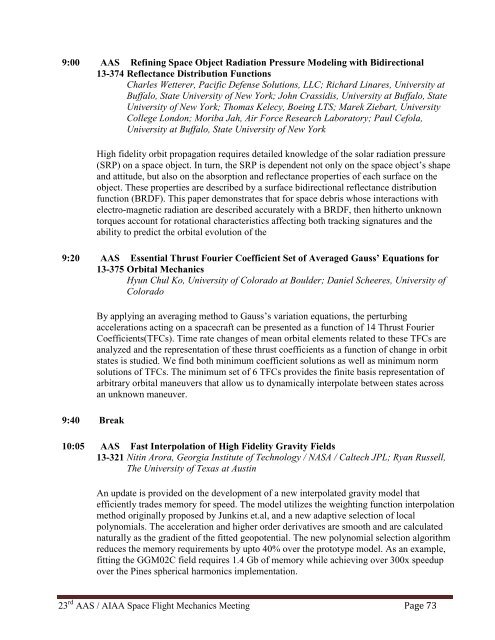meetings - Space Flight Mechanics Committee
meetings - Space Flight Mechanics Committee
meetings - Space Flight Mechanics Committee
Create successful ePaper yourself
Turn your PDF publications into a flip-book with our unique Google optimized e-Paper software.
9:00 AAS Refining <strong>Space</strong> Object Radiation Pressure Modeling with Bidirectional<br />
13-374 Reflectance Distribution Functions<br />
Charles Wetterer, Pacific Defense Solutions, LLC; Richard Linares, University at<br />
Buffalo, State University of New York; John Crassidis, University at Buffalo, State<br />
University of New York; Thomas Kelecy, Boeing LTS; Marek Ziebart, University<br />
College London; Moriba Jah, Air Force Research Laboratory; Paul Cefola,<br />
University at Buffalo, State University of New York<br />
High fidelity orbit propagation requires detailed knowledge of the solar radiation pressure<br />
(SRP) on a space object. In turn, the SRP is dependent not only on the space object’s shape<br />
and attitude, but also on the absorption and reflectance properties of each surface on the<br />
object. These properties are described by a surface bidirectional reflectance distribution<br />
function (BRDF). This paper demonstrates that for space debris whose interactions with<br />
electro-magnetic radiation are described accurately with a BRDF, then hitherto unknown<br />
torques account for rotational characteristics affecting both tracking signatures and the<br />
ability to predict the orbital evolution of the<br />
9:20 AAS Essential Thrust Fourier Coefficient Set of Averaged Gauss’ Equations for<br />
13-375 Orbital <strong>Mechanics</strong><br />
Hyun Chul Ko, University of Colorado at Boulder; Daniel Scheeres, University of<br />
Colorado<br />
9:40 Break<br />
By applying an averaging method to Gauss’s variation equations, the perturbing<br />
accelerations acting on a spacecraft can be presented as a function of 14 Thrust Fourier<br />
Coefficients(TFCs). Time rate changes of mean orbital elements related to these TFCs are<br />
analyzed and the representation of these thrust coefficients as a function of change in orbit<br />
states is studied. We find both minimum coefficient solutions as well as minimum norm<br />
solutions of TFCs. The minimum set of 6 TFCs provides the finite basis representation of<br />
arbitrary orbital maneuvers that allow us to dynamically interpolate between states across<br />
an unknown maneuver.<br />
10:05 AAS Fast Interpolation of High Fidelity Gravity Fields<br />
13-321 Nitin Arora, Georgia Institute of Technology / NASA / Caltech JPL; Ryan Russell,<br />
The University of Texas at Austin<br />
An update is provided on the development of a new interpolated gravity model that<br />
efficiently trades memory for speed. The model utilizes the weighting function interpolation<br />
method originally proposed by Junkins et.al, and a new adaptive selection of local<br />
polynomials. The acceleration and higher order derivatives are smooth and are calculated<br />
naturally as the gradient of the fitted geopotential. The new polynomial selection algorithm<br />
reduces the memory requirements by upto 40% over the prototype model. As an example,<br />
fitting the GGM02C field requires 1.4 Gb of memory while achieving over 300x speedup<br />
over the Pines spherical harmonics implementation.<br />
23 rd AAS / AIAA <strong>Space</strong> <strong>Flight</strong> <strong>Mechanics</strong> Meeting Page 73
















